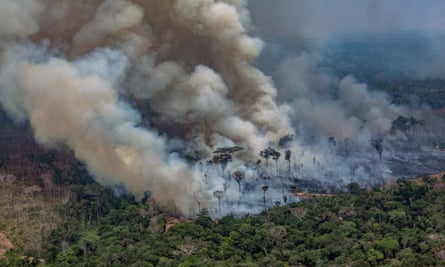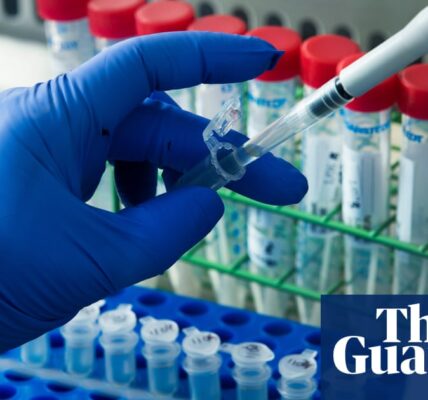15 Concerns for Biodiversity in 2024: From DNA Printing to Anti-Bird Towers
E
Each year, William Sutherland, a conservation biologist from Cambridge University, leads a team in conducting a horizon scan to determine the most influential technological, political, economic, and related changes that will impact biodiversity globally in the upcoming year.
These are the top 15 concerns that will affect the environment in 2024.
Is Hydrogen experiencing a peak or a downfall?
As attempts to mitigate the effects of climate change continue, hydrogen is gaining popularity as a substitute for traditional fuels. However, the impact on biodiversity from utilizing this alternative energy source varies depending on the method of production.
The use of natural gas to create hydrogen still relies on harmful fossil fuels, which contribute to climate change. Producing hydrogen from freshwater or seawater, or extracting it from underground reservoirs, may also have unintended negative effects such as damaging habitats or causing disruption.
If the production, distribution, and deployment of hydrogen are not carefully designed, they may add to greenhouse gas emissions. It will be crucial to make sure that the benefits outweigh the negative impacts when implementing this combination climate solution.
Ammonia dilemma
Ammonia plays a crucial role in the creation of agricultural fertilizers. However, the production process requires significant energy, primarily obtained from non-renewable sources such as fossil fuels.
A new method, which entails spraying small water droplets onto a magnetic mesh, shows potential for significantly lowering the expense and environmental impact of ammonia production to combat climate change. Yet, it also presents possible risks.
One possible outcome of producing ammonia more affordably and with less carbon emissions is the potential for increased fertilizer usage, leading to potential environmental hazards such as air and water pollution. Furthermore, since fertilizer can contribute to the production of nitrous oxide, a powerful greenhouse gas, the overall impact on the climate may not be as positive as initially thought.
Microbes
Scientists have found that smaller food sources can be more environmentally friendly and could have a significant impact on decreasing the dangers to biodiversity caused by land use changes, overfishing, nutrient contamination, and climate change. They have also devised techniques for growing bacteria using hydrogen, nitrogen, and carbon dioxide.

The final product, which has been authorized for consumption in Singapore, has a mild taste and can be added to different processed foods to increase protein levels. If the ingredients are made with sustainable energy, the product could have a significantly lower carbon footprint and environmental impact compared to traditional sources of protein such as meat and dairy.
Crops in the dark
Plants have a remarkable ability to create nourishment for themselves and other organisms by utilizing sunlight, water, and carbon dioxide. However, this process is not very efficient. Fortunately, scientists have devised a new method that involves using electricity, water, and carbon dioxide to generate acetate. This compound can serve as a substitute for glucose, which is typically produced through photosynthesis and aids in promoting plant growth.
The use of biochemical methods has the potential to greatly enhance the efficiency of plant growth in controlled environments, potentially eliminating the need for natural light. If the energy source is renewable, this could lead to highly effective and eco-friendly indoor food production, helping to preserve natural habitats by decreasing the demand for farmland.
Rock dust
One proposed method for addressing the issue of climate change is to distribute rock dust that can capture carbon on agricultural lands. Research indicating that this practice can also enhance crop growth may result in its implementation before fully understanding its potential benefits and drawbacks.
Other potential advantages may include promoting the growth of helpful microorganisms in the soil, minimizing the risk of excess nutrients in freshwater, and reducing acidity levels in both soil and seawater. However, there is also a possibility of negative effects, such as an increase in silt runoff to bodies of water, worsening pollution from heavy metals, harm to soil-dwelling organisms, and the promotion of increased mining activities.
Factors such as availability, clearer explanation of advantages, and government support or discouragement will impact the potential adoption of this innovation.
Disappearing earthworms
Earthworms have a crucial function in various ecosystems, such as farmlands, where they recycle deceased plant material, release nutrients, and improve soil condition. These creatures work quietly underground and are often overlooked or forgotten.

Upon further examination, it becomes apparent that it is necessary to give this matter more weight. According to a recent study in the United Kingdom, the population of earthworms has decreased by at least one-third in the last 25 years, likely as a result of heightened pesticide usage.
If this pattern continues in other places – and no action is taken to address it – the consequences could be significant and negative, not only for the health of ecosystems, but also for the Earth’s ability to provide food for a growing human population.
Listening to soil
What is the appearance of healthy soil? Traditional methods of assessing soil health and identifying potential improvements involve physically digging, which is a laborious and costly process.
New advancements in technology allow us to detect the condition of soil under the surface using sound-capturing techniques. This enables us to track the location and movements of underground invertebrates as they carry out their daily activities.
Soil ecoacoustics is a method that can accurately assess soil health without causing harm. This method has the potential to not only analyze soil health with ease, but also monitor and improve the restoration of damaged soils. This can help these soils to better support diverse and healthy habitats.
Efforts are being made to make the technology user-friendly for citizen scientists and to devise methods for integrating it with other methods of environmental monitoring.
Smoke and climate
The quantity of smoke present in the atmosphere is expected to rise in the coming years due to more frequent and intense wildfires. It is becoming more evident that the presence of smoke in the air can have significant impacts on Earth’s climate.

Particles released from intentional burning, such as for forest clearing or cooking, and other fires can interfere with typical climate patterns and change the distribution of temperature and pressure in the atmosphere by obstructing sunlight and redistributing moisture in the air.
Living organisms, including plants and animals, as well as entire ecosystems, have adapted to the current patterns of climate. Significant shifts in these patterns could disrupt the delicate balance of nature, leading to negative impacts on biodiversity as a whole and on human well-being.
Ignore the promotion for the newsletter.
after newsletter promotion
The DNA machine
Recent developments in genetic studies have enabled the production of personalized strands of DNA with relative ease. Continued progress in this field could potentially result in the capability to utilize a printing device to create extended genetic sequences that encode desired characteristics, and subsequently incorporate them into living beings.
The outcome presents a range of potential effects on conservation, both advantageous and disadvantageous. On the positive side, this technology has the potential to decrease the necessity for deforestation for farming, decrease the use of environmentally harmful chemicals, enhance the adaptability of organisms to environmental changes, and provide alternative means of controlling pests.
Simultaneously, unregulated or malicious utilization could result in the creation of modified versions of current organisms that could replace natural counterparts and cause disturbances in ecosystems. The abundance of options may prompt global attempts to control their implementation.
Predicting toxicity
In the past, people determined the harmfulness of a chemical to organisms and environments by using it and examining the results. Fortunately, a new method is developing.
Researchers are investigating the possibility of utilizing current knowledge on the behavior of different chemicals in the environment, organisms, and at the molecular level to forecast potential negative effects of newly developed compounds. This strategy, called “adverse outcome pathways,” could greatly benefit from advancements in machine learning, deep learning, and artificial intelligence.
Screening substances in this manner could potentially aid in the identification of beneficial ones, such as those that enhance food production, while causing minimal harm.
Bird-bashing skyscrapers
Every year in the fall, over 100 different species of birds from Europe migrate south along a route that splits at the Red Sea. In the way of their migration is a towering complex that spans 13 square miles (34 sq km) and reaches a height of 500m (1,600 feet) as part of Saudi Arabia’s Neom megacity project.
Sitting at the northern tip of the Red Sea, adorned with shiny surfaces, and possibly featuring wind turbines, the enormous structure in its current form could pose a danger to the many migrating birds that rely on this path.
Without an environmental evaluation to determine and provide a foundation for strategies to reduce the danger, researchers are concerned that a significant destruction of skyscrapers may occur, causing disruptions in ecological systems as a decrease in passerine birds changes the dynamics of predator-prey relationships at both ends of their migration route.
The death of sea urchins is a tragic event that can have serious consequences for marine ecosystems.
The passing of sea urchins is a sorrowful occurrence that can result in significant impacts on marine ecosystems.
Sea urchins play a pivotal role in maintaining the integrity of coral reefs by nibbling on algae that otherwise would overwhelm the ecosystem. So when massive urchin die-offs occurred in both the Caribbean and Mediterranean Seas in 2022 and then appeared to spread to the Red Sea, scientists knew it spelled trouble for underwater ecosystems.

While the reason behind the mass deaths of European species is still unknown, scientists have linked the presence of a ciliated microorganism as a probable cause for the devastation in the western Atlantic. If a similar microbe is discovered to be responsible for the disaster in the Mediterranean, it could indicate a change in environmental factors that promote the proliferation of ciliate microbes in other marine habitats.
The consequences could be severe because this group of harmful organisms has a history of infecting various marine animals like fish, corals, and crabs.
Storing carbon in the ocean involves the process of sequestration.
2, the ocean is the largest carbon sink.
Is there an excess of carbon dioxide in the air? Bring in the ocean! With its vast coverage of almost 75% of the Earth’s surface, the ocean is renowned for its capacity to absorb CO2 and is considered the biggest reservoir for carbon.2
The seven oceans are being considered as potential locations for reducing the excessive amounts of greenhouse gases that humans have emitted into the atmosphere.
2
Proposed strategies to increase the oceans’ ability to absorb CO2.22
Rewording: The process involves adding fertilizer to seawater, cultivating and storing algae, raising the pH of ocean water, and actively injecting CO2.2
Beneath the surface, the material transforms into solid rocks.
While the idea of these approaches may seem promising, the authors of the horizon scan caution proponents to consider a few factors before implementing them. Firstly, since these strategies have not been thoroughly tested, their effectiveness in storing carbon is uncertain. Additionally, there is a possibility of unintended negative impacts on biodiversity and society.
Is there an issue in the twilight zone?
The area of the ocean known as the mesopelagic or “twilight” zone, which lies between 200 and 1,000 metres (700 and 3,000 feet) below the surface, is a thriving habitat for a variety of fish and other marine organisms. As these creatures excrete and die, their remains sink to the ocean floor, providing a source of nutrients for deep-sea creatures.
Moreover, over time, a portion of this substance is deposited in sediment, effectively trapping carbon from the air and reducing its impact on the planet’s temperature. When the organic matter sinks in larger chunks, it does so at a quicker rate and has the potential to hold onto carbon for a longer period compared to when it sinks in smaller pieces.
The issue at hand is that the Earth’s atmosphere is heating up due to higher levels of greenhouse gases, which also means that the twilight zone is also warming. This is causing concern among scientists, who believe that this warming could result in a faster breakdown of organic matter. This would not only impact the nourishment of sea creatures below, but also hinder the process of carbon sequestration.
Ocean currents
Below the water’s surface, streams of water flow between different locations, moved by differences in temperature and salt levels. Human actions, such as increasing levels of greenhouse gases in the air, are causing changes in these underwater currents. This is creating new and sometimes unsettling environments for all types of marine creatures.
According to the authors, the Antarctic abyssal overturning current, which has not received much attention so far, deserves more consideration. It is predicted that the current will significantly decrease in speed in the next 25 years due to changes in salt levels caused by ice melting.
This change could potentially decrease the amount of oxygen present in the ocean and also affect the abundance of resources and suitable environments for both marine and terrestrial organisms. Additionally, other variables like changing wind patterns could have a variety of effects on oceanic life that may be difficult to predict.
-
.
The original source of this article is Ensia.
Source: theguardian.com



